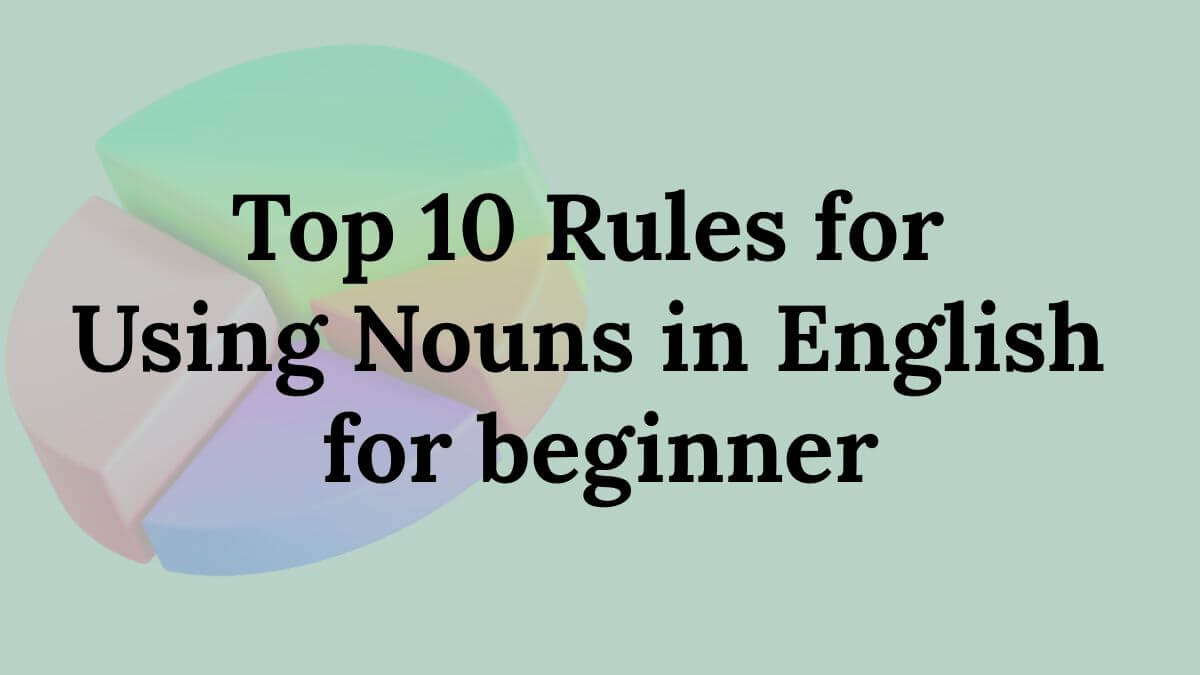Grasping the role of nouns is like unlocking the doorway to clear and confident English communication. In this guide, we’ll explore the Top 10 Rules for using nouns correctly—essential for learners and helpful for teachers. These rules will make your writing clearer and your communication more effective. Whether you’re a beginner or brushing up on grammar, this blog will walk you through the most important rules, give you helpful examples, and explain how nouns work in real-life situations.
What Is a Noun?
A noun is the naming heart of every sentence, identifying who we are, where we go, what we see, and even what we feel.. If you can spot it, feel it, call it something, or imagine it—it’s probably a noun.. For example: teacher, London, apple, freedom, and happiness. There are several types of nouns—common, proper, abstract, collective, countable, and uncountable—and each follows specific rules. Let’s explore the Top 10 Rules for using them correctly.
Rule 1: Always Capitalize Proper Nouns
Proper nouns refer to specific names of people, cities, companies, days, etc. Always start them with a capital letter. Top 10 Rules
Example:
- I visited Paris in summer.
I visited paris in summer. - Rule 2: Use Singular and Plural Forms Correctly
Most nouns turn plural simply by adding “-s” or “-es,” giving words the power to count beyond one. However, there are irregular forms too.
Examples:
- Book → Books
- Box → Boxes
- Child → Children
- Mouse → Mice
Remember: Each noun follows specific pluralization patterns, and it’s important to learn them to avoid mistakes. Top 10 Rules
Rule 3: Understand Countable vs. Uncountable Nouns
Countable nouns are things you can count (e.g., apple, car, pen).
Uncountable nouns represent substances or concepts that cannot be separated into individual elements for counting, like honesty, milk, or knowledge.
Examples:
- I need two apples. (Countable)
- She gave me some information. (Uncountable)
- Use ‘many’ for things you can count—like apples, books, or cars—and ‘much’ for what you can’t, like water, sugar, or advice.
Rule 4: Match the Noun with the Correct Article
Articles like “a,” “an,” and “the” must match the noun they describe.
- Use “a” before consonant sounds: a cat, a house
- Use “an” before vowel sounds: an apple, an umbrella
- Use “the” for specific nouns: the teacher, the Eiffel Tower
Rule 5: Use Possessive Nouns Properly
Possessive nouns show ownership. For singular nouns, add ‘s. For plural nouns that end in “s”, just add an apostrophe. Top 10 Rules
Examples:
- The girl’s book (one girl)
- The girls’ room (more than one girl)
Rule 6: Be Aware of Abstract vs. Concrete Nouns
Concrete nouns name what you can see or hold, while abstract nouns express what you can feel or imagine. Knowing this difference helps you understand the context better and express yourself more clearly.
Rule 7: Use Collective Nouns for Groups
A collective noun refers to a group of people or things, such as team, class, herd, or flock. Top 10 Rules
Examples:
- The team is playing well.
- A flock of birds flew over us.
Even though a group consists of many individuals, it is typically seen as one unit and takes a singular verb.
Rule 8: Recognize Gender-Specific and Neutral Nouns
Some nouns indicate gender (actor/actress, king/queen), but many English nouns are now gender-neutral.
Examples:
Fireman → Firefighter
Chairman → Chairperson
Using neutral nouns helps you communicate more inclusively and respectfully.
Read More :
A Simple Guide to the Parts of Speech with Examples
Basic Sentence Structure Made Easy With Clear Examples
Rule 9: Don’t Forget Irregular Plurals
Some nouns don’t follow the normal plural rules. You’ll need to memorize these.
Examples:
- Man → Men
- Woman → Women
- Tooth → Teeth
- Foot → Feet
Using these incorrectly can confuse your meaning, so watch out for them.
Rule 10: Keep Consistency in numbers
When using nouns in sentences, ensure the verb agrees in number (singular/plural) with the noun.
Examples:
- The cat runs fast.
- The cats run fast.
- The cats runs fast.
This rule is essential for both writing and speaking clearly.
Final Thoughts on the Top 10 Rules
Learning and applying the Top 10 Rules for using nouns in English is key to building strong grammar skills. These rules not only help you avoid common mistakes but also improve your fluency and confidence when using English. Whether you’re preparing to teach English or learning it yourself, these simple yet powerful rules will guide you in mastering noun usage. Keep practicing with real examples, and soon, using nouns correctly will become second nature.
